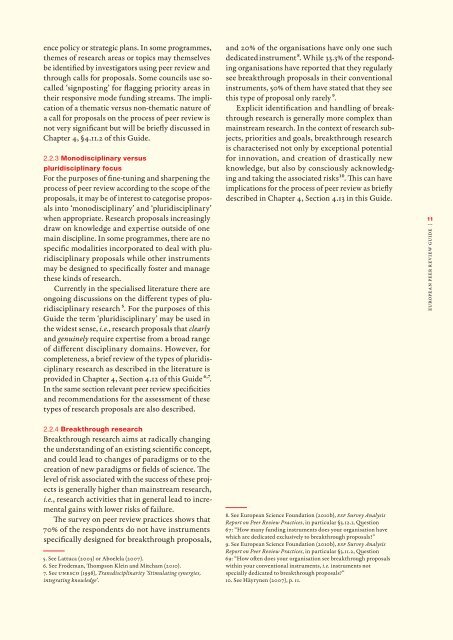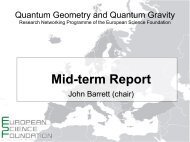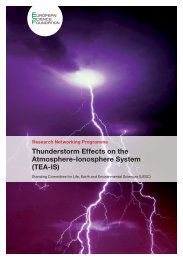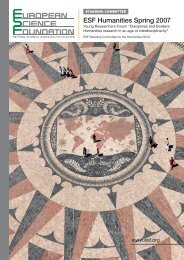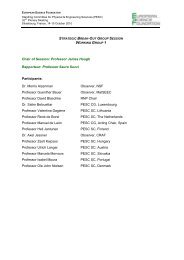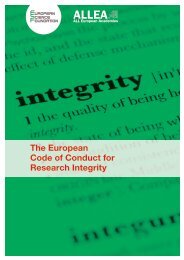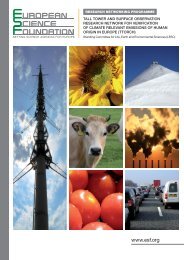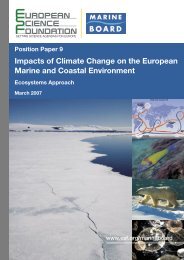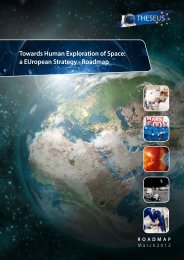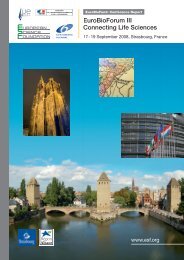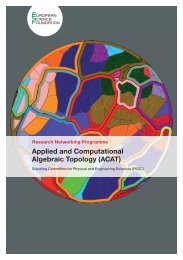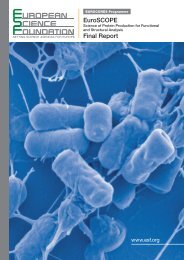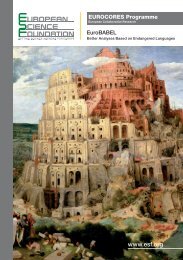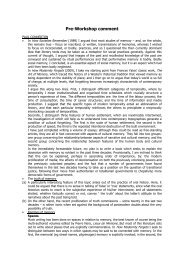European Peer Review Guide - European Science Foundation
European Peer Review Guide - European Science Foundation
European Peer Review Guide - European Science Foundation
You also want an ePaper? Increase the reach of your titles
YUMPU automatically turns print PDFs into web optimized ePapers that Google loves.
ence policy or strategic plans. In some programmes,<br />
themes of research areas or topics may themselves<br />
be identified by investigators using peer review and<br />
through calls for proposals. Some councils use socalled<br />
‘signposting’ for flagging priority areas in<br />
their responsive mode funding streams. The implication<br />
of a thematic versus non-thematic nature of<br />
a call for proposals on the process of peer review is<br />
not very significant but will be briefly discussed in<br />
Chapter 4, §4.11.2 of this <strong>Guide</strong>.<br />
2.2.3 Monodisciplinary versus<br />
pluridisciplinary focus<br />
For the purposes of fine-tuning and sharpening the<br />
process of peer review according to the scope of the<br />
proposals, it may be of interest to categorise proposals<br />
into ‘monodisciplinary’ and ‘pluridisciplinary’<br />
when appropriate. Research proposals increasingly<br />
draw on knowledge and expertise outside of one<br />
main discipline. In some programmes, there are no<br />
specific modalities incorporated to deal with pluridisciplinary<br />
proposals while other instruments<br />
may be designed to specifically foster and manage<br />
these kinds of research.<br />
Currently in the specialised literature there are<br />
ongoing discussions on the different types of pluridisciplinary<br />
research 5. For the purposes of this<br />
<strong>Guide</strong> the term ‘pluridisciplinary’ may be used in<br />
the widest sense, i.e., research proposals that clearly<br />
and genuinely require expertise from a broad range<br />
of different disciplinary domains. However, for<br />
completeness, a brief review of the types of pluridisciplinary<br />
research as described in the literature is<br />
provided in Chapter 4, Section 4.12 of this <strong>Guide</strong> 6,7.<br />
In the same section relevant peer review specificities<br />
and recommendations for the assessment of these<br />
types of research proposals are also described.<br />
and 20% of the organisations have only one such<br />
dedicated instrument8. While 33.3% of the responding<br />
organisations have reported that they regularly<br />
see breakthrough proposals in their conventional<br />
instruments, 50% of them have stated that they see<br />
this type of proposal only rarely 9.<br />
Explicit identification and handling of breakthrough<br />
research is generally more complex than<br />
mainstream research. In the context of research subjects,<br />
priorities and goals, breakthrough research<br />
is characterised not only by exceptional potential<br />
for innovation, and creation of drastically new<br />
knowledge, but also by consciously acknowledging<br />
and taking the associated risks10. This can have<br />
implications for the process of peer review as briefly<br />
described in Chapter 4, Section 4.13 in this <strong>Guide</strong>.<br />
11<br />
<strong>European</strong> <strong>Peer</strong> <strong>Review</strong> <strong>Guide</strong><br />
2.2.4 Breakthrough research<br />
Breakthrough research aims at radically changing<br />
the understanding of an existing scientific concept,<br />
and could lead to changes of paradigms or to the<br />
creation of new paradigms or fields of science. The<br />
level of risk associated with the success of these projects<br />
is generally higher than mainstream research,<br />
i.e., research activities that in general lead to incremental<br />
gains with lower risks of failure.<br />
The survey on peer review practices shows that<br />
70% of the respondents do not have instruments<br />
specifically designed for breakthrough proposals,<br />
5. See Lattuca (2003) or Aboelela (2007).<br />
6. See Frodeman, Thompson Klein and Mitcham (2010).<br />
7. See UNESCO (1998), Transdisciplinarity ‘Stimulating synergies,<br />
integrating knowledge’.<br />
8. See <strong>European</strong> <strong>Science</strong> <strong>Foundation</strong> (2010b), ESF Survey Analysis<br />
Report on <strong>Peer</strong> <strong>Review</strong> Practices, in particular §3.12.1, Question<br />
67: “How many funding instruments does your organisation have<br />
which are dedicated exclusively to breakthrough proposals?”<br />
9. See <strong>European</strong> <strong>Science</strong> <strong>Foundation</strong> (2010b), ESF Survey Analysis<br />
Report on <strong>Peer</strong> <strong>Review</strong> Practices, in particular §3.11.2, Question<br />
69: “How often does your organisation see breakthrough proposals<br />
within your conventional instruments, i.e. instruments not<br />
specially dedicated to breakthrough proposals?”<br />
10. See Häyrynen (2007), p. 11.


